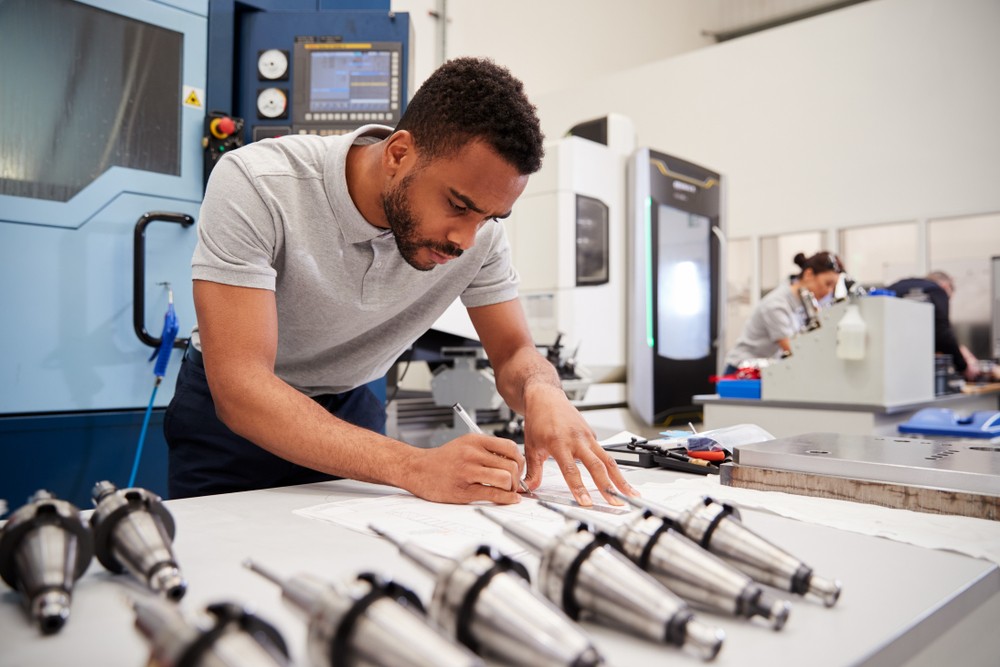Are Manufacturing Jobs Good? They’re Even Better Than Advertised!

Manufacturing has an employment problem. While employment numbers ebb and flow with the condition of the economy, manufacturing faces an uphill battle in attracting and maintaining a skilled workforce. But why? The prevailing theory is that young students and job seekers don’t fully understand the manufacturing career track. As a result, they’re not as optimistic or informed about factors like earning potential, upward mobility, career paths, and potential employers. The uphill battle starts with demystifying manufacturing jobs.
Not your grandpa’s factory work
Factory work has an ongoing image problem that dates back to industrialization. Images of assembly lines, dim factories, and repetitive tasks are generally what come to mind for the uninformed job seeker when presented with an industrial career path. But modern manufacturing couldn’t be further from these misconceptions.
Today’s manufacturing environments are some of the most state-of-the-art in any sector. Repetitive tasks are handled by robots, while humans power the real innovation within the value stream. Manufacturing has transitioned from a brawn-to-brains field that’s continuously pushing into new territory. It’s a field built for the modern worker.

Opportunities abound in manufacturing
Beyond breaking through misconceptions and antiquated stereotypes of manufacturing, the best way to stimulate an influx of new talent is to present the opportunities of a manufacturing career in no uncertain terms. For those seeking a lifelong career in a field rife with innovation and opportunity, manufacturing has much to offer.
With the sweeping technological change in manufacturing, comes strong incentives for new employment. New technologies necessitate new training, which facilitates upskilling, which begets higher wages. This breadth of new skills and technologies also opens the door for upward mobility as innovation continues to shape industry. Career-driven manufacturing professionals can look forward to growth potential, instead of stagnation.
Perhaps the best argument for a career in manufacturing is the broad availability of positions. Manufacturing is desperate for new talent and prepared to pay, educate, and enable workers! From machine operators, to human-machine interface (HMI) programmers, tool and die makers, injection molding experts, and myriad other jobs are growing and in-demand. The best part? Many manufacturers welcome entry-level candidates and promote from within, choosing to cultivate talent for the long-term. Add job security to the list of benefits.

The path to success is illuminated
Manufacturing’s future looks brighter in a post-COVID-19 world, but only if it welcomes a new wave of talent to meet demand. Thankfully, entry into the field is easier than ever, with few barriers to stop ambitious individuals.
Schools across the country have begun prioritizing STEM (science, technology, engineering, mathematics) education, beginning as early as K-5 schooling. High-school students are eligible for scholarships, grants, and financial aid as they pursue trade schools and STEM education at the university level. And, as they near the end of their formal education, internships, externships, and recruitment programs connect eager job seekers to their first formal position. It’s a process designed to be seamless and promote the success of a manufacturing future.
As young adults contemplate their career, they’re faced with the decision to take a service position or follow a trade career track. Recent data shows the latter is not only more lucrative, it’s more sustainable. In an economy that’s preparing to embrace manufacturing growth in 2021 and beyond, the top priority is an eager, enthusiastic, engaged workforce. It’s up to new entrants into the job market to see the many opportunities manufacturing offers.